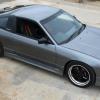M35 Blown Turbo?
Announcements
-
Similar Content
-
Latest Posts
-
By robbo_rb180 · Posted
Yep he is an awesome bloke, we work together on that car. You will have fun at the 6hr, Tony doesn't stuff around when he goes racing does pretty well. -
Did you check Matt's suggestion? If the ECU is not powering up it will crank but not earth the fuel pump. You can also check the input to the fuel pump relay, it should earth for say 3 seconds when the key goes from ACC to ON, and also at all times when the key is at STRT
-
Yep, I got the pedal, it was a huge thing I made sure I got for it. I have the CigWeld 205ACDC, with all the parts for it. Yes, Benny is good friends with Tony who owns it. I work across the car park from it. We presently have the Clio in our workshop. I met Benny for the first time a couple of weeks ago, nice guy! Was he at MSR with you? I know he worked recently on one of the V8s entered in as a wildcard.
-
That shed is wicked mate! I should come for a drive out to see the setup one day! Maybe you can give me some pointers to improve my terrible TIG welding while I'm there! Ha ha ha Nice to see some work on the 15 happening
-
Bit late, but the factory balance tube is fine, that's why its there (stable post throttle pressure source).
-




Recommended Posts
Create an account or sign in to comment
You need to be a member in order to leave a comment
Create an account
Sign up for a new account in our community. It's easy!
Register a new accountSign in
Already have an account? Sign in here.
Sign In Now